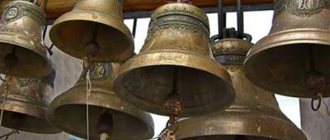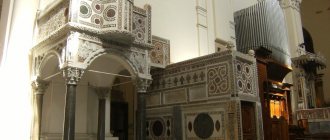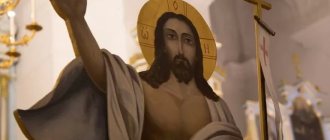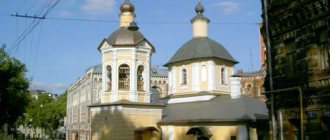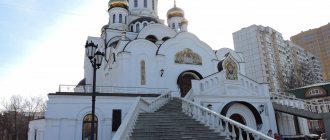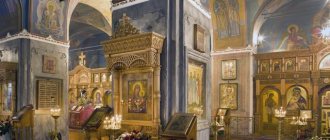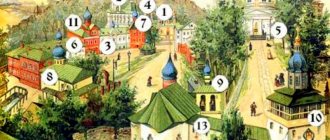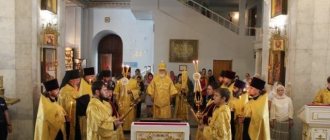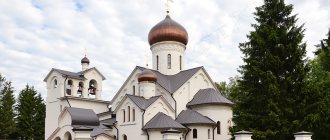There are only 2 types of chapels in an Orthodox church
In total, there are two types of chapels in the church: central and additional.
The central one is otherwise called the main altar, and is usually located in the main part of the temple, usually opposite the entrance.
The arrow shows what the central aisle of the temple looks like
Additional chapels can have different shapes and be distributed differently in the space of the temple, complicating its structure and sometimes turning it into a whole complex.
Under the number 1 is the central aisle, but under the number 2 is an additional aisle
Each temple is dedicated to God, but may be named after a sacred event, a revered icon, or a saint significant to those people who decided to build the temple.
The consecration of the temple is the most important rite, without which services cannot be held in the temple. It is performed either by the bishop or by a priest specially delegated to consecrate the temple.
The future Throne is washed with water and wine, consecrated by the bishop’s prayer, mixed with incense, as a sign of memory that from the Wound of Christ, when He was pierced on the Cross by the centurion Longinus, Blood and water flowed.
The photo shows how the bishop washes the future throne with water in a small altar, the rest of the priesthood is present at the same time
The throne is anointed with myrrh - the same oil through which the Holy Spirit descends on all Christians immediately after Baptism.
The acquisition of the Holy Spirit, according to the words of St. Seraphim of Sarov, “is the goal of Christian life.” Such anointing is subsequently performed over the walls of the entire temple.
It is very interesting that this myrrh is prepared specifically and only for performing the Sacrament over a person, but is used here to sanctify inanimate objects.
It is this sacred act that shows us the inexpressible difference between a simple building and a temple, the house of Almighty God. Thanks to him, even dilapidated churches desecrated by years of atheism retain this atmosphere of the prayer that was once performed in it...
Varieties of aisles
In terms of layout, chapels can also differ significantly from each other. These can be naves parallel to each other, separated from each other by only a few columns in a basilica church, or they can be bizarrely located rooms isolated from each other, as in the already mentioned St. Basil's Cathedral. Chapels can also be located in the choir of the temple or, for example, in an underground room. Finally, church buildings with chapels located in extensions to the main building are common.
A piece of relics is placed at the base of the throne
A very interesting point is that a piece of the relics of a martyr is necessarily placed at the base of the throne.
This continuity already comes from antiquity: for the first three centuries after the Nativity of the Savior, while under persecution, Christians performed their most important sacred rite - the Divine Liturgy - somewhere in the catacombs or underground burials.
The Tabernacle of Meeting is the Jewish camp temple.
And they certainly did this over the tombs of those who, with their lives, even to death, testified to the incarnate Savior that He conquered death. After all, this is exactly how a martyr is initially translated from ancient Greek as a witness.
The consecration of the temple and its dedication to God is an ancient and everlasting custom of the Church of God. Moses, at the command of God, consecrated the tabernacle and its accessories (Gen. 40:9).
This is exactly how the Jewish prophet and founder of Judaism Moses was portrayed in the Bible. It was he who, at the command of God, consecrated the tabernacle and all its accessories
Solomon consecrated the temple he had newly created and celebrated the consecration for seven days (2 Chron. 7, 8-9).
After the captivity of Babylon, the Jews under Ezra renovated the second temple (1 Ezra 6:16), and after the cleansing of the temple from the persecution of Antiochus, they established the annual seven-day festival of Renewal.
The tabernacle and temple were consecrated by bringing in the ark of the covenant, singing a sacred song, sacrifice, pouring out sacrificial blood on the altar, anointing with oil, prayer and a national holiday (Ex. 40; 1 Kings 8 ch.).
The central altar was always consecrated in honor of the one to whom the temple was dedicated
For example, if the central chapel is consecrated in honor of St. Nicholas, then the temple will be called St. Nicholas.
Or, if the temple is consecrated in honor of the Resurrection of our Lord Jesus Christ, then the temple will be called Resurrection.
Or, if the temple is dedicated to the Kazan Icon of the Mother of God, then the temple will be called Holy Kazan. And so on.
The number of additional aisles can be 2 or 3.
An additional church chapel is usually consecrated in honor of especially revered saints of the area in which the temple was built.
Their number can vary from one to several. In ancient times, they usually did this: they built a small temple in honor of the Lord or the Mother of God, consecrated it, and only then, gradually built refectory parts on all sides, from which they made additional chapels to the temple.
It goes without saying that not every temple has additional chapels; sometimes there is only one central chapel in the temple.
A logical question arises: why were additional aisles created? Isn’t one main, central one enough? The answer to this question is simple.
According to the canons of the Church, that is, those rules that all Orthodox people adhere to, it is impossible to celebrate more than one Divine Liturgy on one altar.
You cannot celebrate two liturgies in one altar in one day.
And since in many churches, due to the large number of parishioners, two or more liturgies per day are performed per day, especially on especially revered days of remembrance of saints, or major feasts, then chapels were created in which they are celebrated liturgy.
Values
The word “ limit ” ( correctly written with the prefix “ pre- ”) is used in the following meanings:
- A certain line, a boundary line, clearly indicated or not: “beyond the Motherland”; " travel limit Synonym for "border". Partial synonyms “edge”, “edge” (for limits not equipped with man-made structures - “hilly limits [hilly edge] of the valley”, “limit of advancement along the slope”, etc.), “border” (mainly for specially equipped limits - “the limits of the pasture are visible from the fence”).
- The extreme degree, the final stage of the process, the last in a series of events: “ the limit of dreams [possibilities, permissible, desires, strengths, perfection, patience, etc.]”, “ the limit of design improvement”; “Will there be a limit to your antics?!” Synonym for "top"; partial “edge”, “edge”, “maximum”, “frontier”.
- The numerical value to which a number sequence, series, function tends: “The number π is obtained as the general limit of sequences to which the sums of the lengths of the sides of regular polygons inscribed in a circle and circumscribed around it tend, with an unlimited increase in their number.” Synonyms “limit”, lim (in specialized literature). Do not confuse the limit of a function with its asymptote and extrema (maxima, minima)!
- Small homeland, native land, home in the sense of a home, a somehow delimited area of space (usually used in the plural): “Having returned to my native borders , I was amazed at the changes that had taken place in them.” Partial synonyms “region”, “country”.
- Established (stable) state (also mainly in the plural): “The birth of a child at first unsettled us, but over time our life entered new, familiar limits .” Partial synonyms “rut”, “channel” (allegorical).
What does “altar” mean?
A chapel of a temple is an extension to it, serving for religious purposes when holding services in the main temple building is undesirable for some reason. The word “chapel” must be written with the prefix “pri-”. The chapels of Christian churches are generally of the following types:
- The so-called summer churches, built at parish churches (on the left in the figure). They serve in the summer chapel not only in the cold season to save on heating costs, but also every day when there is a small influx of parishioners, but holiday services are invariably held in the main church. A Christian summer chapel is built, as a rule, on the southern or northern side of the main church, so that the altar can be placed at the eastern side and the worshipers stand facing there, as it should be. Partial synonyms of “dungeons” (if the chapel has a common wall with the main church), “chapel” (dungeon in a Catholic church), “nave” (for Catholics - a chapel separated from the main religious space not by a blank wall, but by an arch and/or columns ).
- An independent religious building as part of a temple complex, (usually dedicated to one saint or sacred event), services in which can be held in parallel (along with) those in the main temple. On the right in Fig. The chapels of St. Basil's complex are indicated. Partial synonym for "church".
- An extension to the cathedral church, open to the inside, used for performing individual religious actions (confession, baptism, communion, or storing religious paraphernalia). Partial synonyms according to the purpose: “confession room”, “baptistery” (“baptistery” for Catholics), “sacristy”, etc.
Note: do not confuse the chapel of the temple with the porch to it, which is essentially the entrance hall to the temple.
The chapel is primarily an altar where services are performed.
Let's take a closer look at what a chapel is and what it contains. First of all, this is the altar - the main place of the entire Orthodox church. It is in the altar that the main divine service of the entire Christian church is performed.
The word altar comes from the Latin words “alta” and “ara”: an elevated altar or an altar placed on a raised platform.
Only men are allowed to enter the altar; women are not allowed to enter there, because the altar is considered a holy place
It really was always located on a hill compared to the rest of the temple area. Why is that? The altar is a symbol of the Throne of the Lord.
The altar consists of the following important parts:
Altar - a table that is located in the central part of the altar. It is here that the Sacrament of the Eucharist is celebrated, and only priests can touch this table. For laymen this is prohibited.
The lower cover of the Throne is called catasarca, the upper one is called indium, which translated from Greek means “I dress.”
The covering that is used to cover the altar with all the sacred objects on it at the end of the service is called the veil.
In the diagram you can see what is in the altar. The Throne, where the Antimins, the Cross, the Gospel and the Tabernacle are located
The altar is a quadrangular table located in the northeastern part of the altar (to the left of the throne). It got its name from the fact that during proskomedia, bread in the form of prosphora and wine are prepared in a special way for the Sacrament of the Eucharist.
Sacred vessels are stored on the altar until used in the liturgy; it is a sacred place that only clergy are allowed to touch;
Sacristies are a special place located to the right of the throne, where clergy dress in special clothes.
This sacristy stores all the liturgical clothes of priests, deacons and subdeacons, which are necessary for the celebration of the liturgy.
There are also all the liturgical books needed during the Divine Liturgy.
But in Bulgarian churches, especially in ancient churches, the sacristy most often becomes the most ordinary wardrobe or even a simple table.
The high place is a part of the Orthodox church, which is located at the central part of the eastern wall of the altar directly opposite the throne. The mountainous place has ancient origins. In the catacomb crypts and chapels, a cathedra (seat) for the bishop was built on this site.
Number 1 depicts the high seat on which the bishop sits during the Divine Liturgy; number 2 shows the throne.
It is impossible not to notice the altar in the temple, because the prototype of the Throne should be the most beautiful. They always try to decorate and highlight it.
During the Divine Liturgy, the priest either leaves the altar or re-enters it. This happens throughout the liturgy.
Only a few can enter the altar. But it is there that preparation for the Sacrament of the Eucharist takes place. And yet, every baptized man has been to the altar at least once, even if he doesn’t remember it at all.
Holy Fathers about the lighting of the temple
In the writings of the Holy Fathers of the Church, close attention is not paid to the issues of lighting the temple space , however, individual comments are found in the Church. Cyprian of Carthage, St. Simeon the New Theologian, St. Gregory Palamas and St. Simeon of Thessalonica. Some reflections on this topic are also contained in the works of more modern theologians and scientists: St. right John of Kronstadt, Fr. Pavel Florensky, Fr. Lev Lebedev, professors V.N. Lossky and N.D. Uspensky.
The main ideas contained in these works are the famous Russian church architect M.Yu. Kesler summarized as follows: “The light in the temple is, first of all, an image of a special, immaterial, uncreated, Divine light, essentially different from the external, natural, material. External light is allowed inside the temple only as an image of this immaterial light..., since light in the proper sense for the church consciousness is only Divine light, the light of Christ, the light of future life in the Kingdom of God, which is symbolically reflected by the architecture of the Orthodox church."
M.Yu. Kesler
The altar is separated from the rest of the temple by an iconostasis
The altar is separated from the rest of the temple by a special wall with icons - an iconostasis. The first reports of the separation of the altar by a partition or curtain survive from the 4th century.
The arrows show the very wall that separates from the altar. It is behind this wall that there is an altar
According to legend, St. Basil the Great ordered the altar to be closed with a curtain in his church. It is not known exactly how the altar barrier was enlarged and when it turned into an iconostasis.
The royal doors of the 13th-14th centuries, belonging to the Novgorod and Tver schools of icon painting (TtG), have been preserved. On their solid wooden doors, the Annunciation is depicted on top, and Saints Basil the Great and John Chrysostom are depicted in full-length below.
From the 13th century, temple icons have come down, that is, images of saints or holidays in honor of which temples were consecrated. They could also have already been placed in the bottom row of the barrier. For example, these include the Pskov icons “Assumption” and “Elijah the Prophet with the Life”.
XIV
in this century, Deesis icons increase in size, they are usually written at least seven
By the 14th century, Deesis icons increased in size and were usually written at least seven. The State Tretyakov Gallery houses the Deesis rite of the cathedral of the Vysotsky Monastery in Serpukhov.
Deesis icons are those that have Christ in the center, to the left and right of him are the Mother of God and John the Baptist.
One of the ancient Deesis icons, called “Deesis with the Falling Saints”
These are seven very large waist-length icons, executed in Constantinople. After the Mother of God and John the Baptist, they depict the archangels Michael and Gabriel, the apostles Peter and Paul. The Deesis rite from Zvenigorod (early 15th century, Tretyakov Gallery) had a similar composition, three surviving icons of which are attributed to the hand of St. Andrei Rublev.
Immediately behind the iconostasis there is an elevation called the solea.
The solea serves as a proscenium for worship. During liturgical entrances, sextons with candles and serving clergy solemnly walk along the salt.
It is followed by an ambo - a special structure designed for reading the Holy Scriptures, singing or proclaiming some liturgical texts, and delivering sermons. This is followed by a space in which people stand and pray.
The photo shows in detail where the pulpit and sole are located.
It is important to note that both the central and additional aisles are arranged exactly the same and have the same components.
The side chapels can differ only in their splendor, that is, in the materials and quality of finishing.
Usually the central chapel is the most beautiful and majestic in the entire temple.
The additional aisles look much more modest.
Most often, on ordinary weekdays, when there is no need to perform several liturgies, the service is performed in an additional chapel.
This was done because when the service begins to take place in the central chapel, visually for the parishioners it will seem to stand out with pomp and importance.
By leaving a comment, you accept the user agreement
